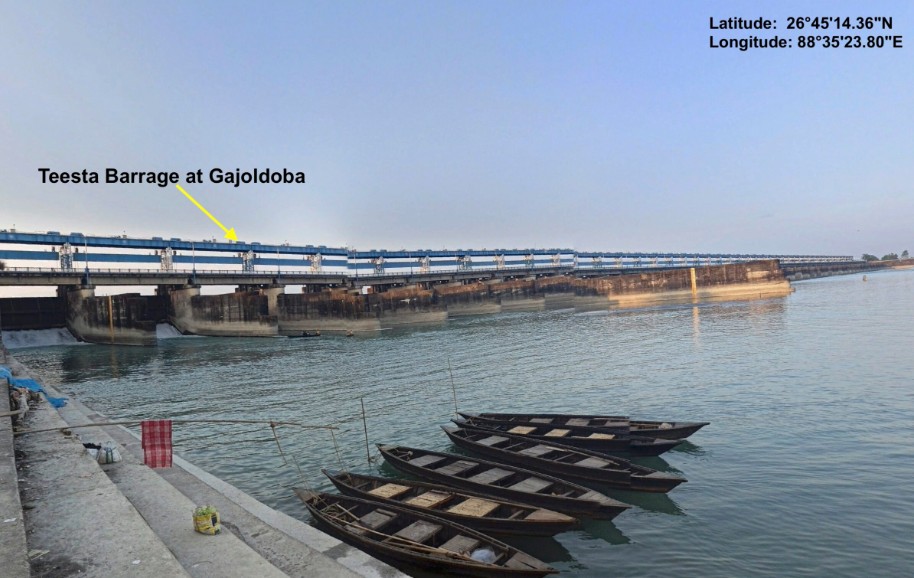A fresh wave of flood threats looms over Bangladesh’s northern districts as major rivers including the Teesta, Dharla, Dudhkumar and Brahmaputra continue to swell following heavy upstream rainfall and a sudden release of water from India’s Gajoldoba barrage.
On Friday, India released over 11,000 cubic metres per second (cusec) of water from the Gajoldoba Barrage without prior notice to Bangladesh, sharply raising the Teesta’s water level. The discharge, combined with ongoing monsoon rains, has pushed the river dangerously close to or above the danger mark at several points, particularly around Lalmonirhat and Rangpur.
According to the Bangladesh Water Development Board, the Teesta was flowing just 7 cm below the danger mark at Dalia point as of Sunday evening, with the flow increasing rapidly over the last 24 hours. Low-lying areas and riverine chars in Gangachara, Dimla, and Hatibandha are already reporting waterlogging and erosion.
Despite the clear cross-border impact, Bangladesh’s Flood Forecasting and Warning Centre said it received no advance warning from Indian authorities about the release, hampering local disaster preparedness.
Local residents remain anxious, with many moving livestock and belongings to higher ground amid fears of sudden inundation. Relief officials are yet to announce any formal evacuation plans, even as red alerts are being issued for several upstream regions.
According to the Bangladesh Water Development Board (BWDB), the water flow at the Teesta Barrage, the country’s largest irrigation project, stood at 52.08 centimeters at 6:00 PM on Sunday, just 7 centimeters below the danger level of 52.15 cm. Over the past 24 hours, water levels have significantly risen.
Preferring anonymity BWDB sources said, the Indian authorities release water in two phases—6,000 cusec at 12:30 p.m. and another 4,700 cusec later in the day—through the Gajoldoba gates, upstream of the Teesta River.
It has raised fresh concerns over bilateral water coordination.
The sudden discharge, coupled with heavy rains, pushed Teesta’s water level close to or above the danger mark, prompting red alerts from Domhani (India) to the Bangladesh border.
Local authorities warned of heightened flash flood and erosion risk in Teesta-adjacent areas and urged residents to stay alert.
In the char areas of Gangachhara in Rangpur, a resident said, “The water level has been rising since morning. It might flood by tonight. We are very worried.” Another resident from the same area added, “The water started rising last night. At least seven unions in Gangachhara’s low-lying char areas have been flooded already.”
In Kurigram, residents of the chars also mentioned that they had not received any flood warnings.
A resident of Teesta’s riverside in Rajarhat, said, “The water is rising, but we haven’t heard anything about preparations. People in the char areas are making their own arrangements.”
Executive Engineer of the BWDB’s Flood Forecasting and Warning Centre, Sardar Uday Raihan, mentioned that a short-term flood situation could occur in the low-lying areas of Rangpur, Kurigram, Nilphamari, and Lalmonirhat near the Teesta River within the next 24 hours.
The flood forecasting center also stated that heavy rainfall in the Indian states of West Bengal, Assam, Arunachal, and Meghalaya has led to a rise in water levels in rivers in the Rangpur and Sylhet divisions of Bangladesh. The water levels in the Teesta, Dharla, Dudhkumar, and Brahmaputra rivers have also increased over the past 24 hours.
In Kurigram, the BWDB reported a rise of 4 cm in the Dharla, 18 cm in the Dudhkumar, 21 cm in the Brahmaputra, and 14 cm in the Teesta.
Kurigram’s district relief and rehabilitation officer, Md Abdul Matin, said that preparations are in place, but no awareness campaigns have begun yet. “We will carry out the campaign in the char areas based on the situation,” he added.
Local farmers in Kurigram’s char areas mentioned that a few weeks ago, there was a drought due to low water levels, but now the sudden rise in water could damage their crops, including rice and vegetables.


